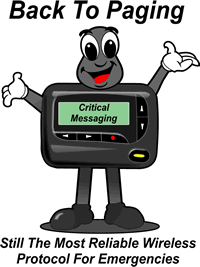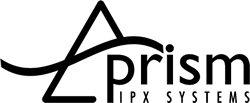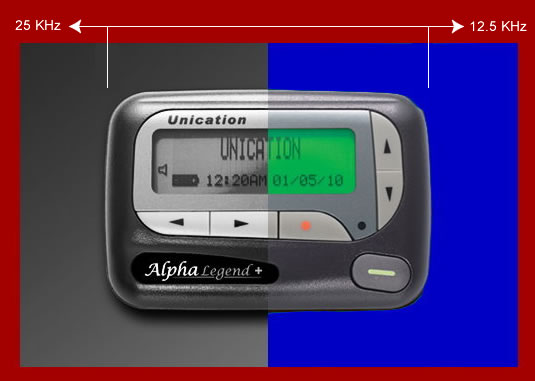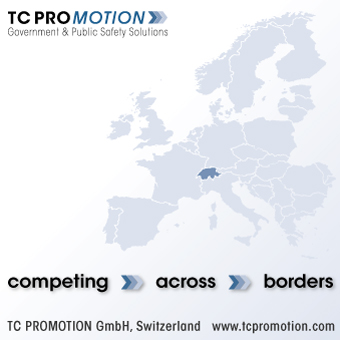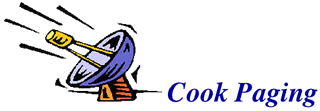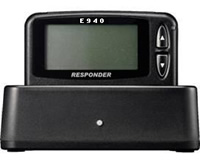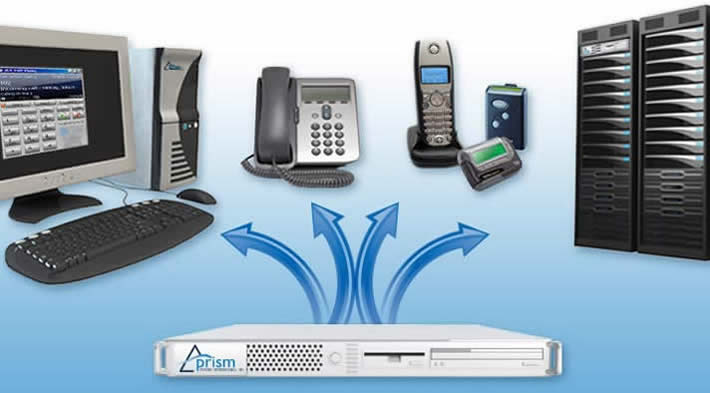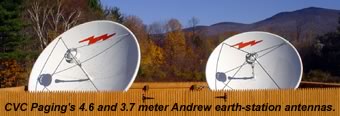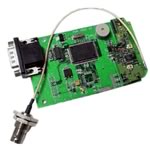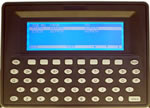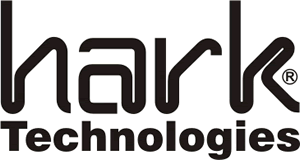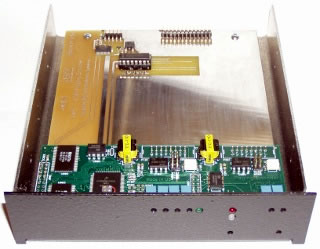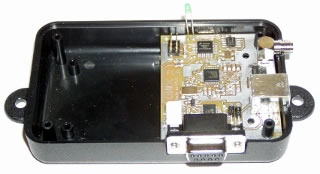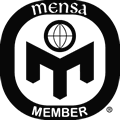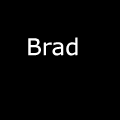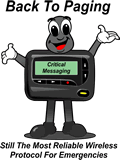BloostonLaw Telecom Update Published by the Law Offices of Blooston, Mordkofsky, Dickens, Duffy & Prendergast, LLP [Portions reproduced here with the firm's permission.] www.bloostonlaw.com |
| Vol. 14, No. 16 | April 20, 2011 |

INSIDE THIS ISSUE - FCC opens new docket on AT&T/T-Mobile merger.
- White House is drafting new legislation on cybersecurity.
- FCC allows more time for E-rate filing corrections.
- FCC seeks further comment on establishing a “Tribal Mobility Fund.”
- FCC, Knight Foundation unveil “contest” for new apps.
|
FCC Opens New Docket On AT&T/T-Mobile Merger The FCC has opened WT Docket No. 11-65 regarding AT&T’s proposed acquisition of T-Mobile USA. As reported previously, AT&T and Deutsche Telekom AG announced an agreement under which AT&T will acquire T-Mobile USA from Deutsche Telekom in a cash-and-stock transaction currently valued at approximately $39 billion (BloostonLaw Telecom Update, March 23). Also, as reported earlier, while the proposed merger would offer certain network efficiencies, it would create a virtual duopoly in the wireless market, and not necessarily result in lower prices for consumers. Additionally, rural carriers likely will be affected by partnerships, roaming agreements, handset availability, and post-transaction divestiture requirements. Clients should follow the submissions in the new docket, and contact us with questions or concerns that may warrant the filing of comments or ex parte presentations. The FCC said it expects applications to be filed seeking consent to the transfer of control of T-Mobile and its wholly-owned and controlled subsidiaries to AT&T. As a result, the Commission opened the new docket and issued a Public Notice (PN) to “articulate the ex parte status of discussions related to the proposed transaction.” However, the FCC said its administrative opening of a docket related to the proposed transaction is not intended to change the ex parte status of the proposed transaction. Accordingly, the FCC added, until the applications are filed, discussions with Commission staff regarding this proposed transaction will continue to be exempt from any ex parte limitations or requirements. The FCC also said it may adopt modified or more stringent ex parte procedures in particular proceedings if the public interest so requires. Additionally, the FCC announced that as of the time any applications are filed, this WT Docket No. 11-65 proceeding will be governed by permit-but-disclose ex parte procedures that are applicable to non-restricted proceedings under section 1.1206 of the Commission’s rules. Further, the FCC said that parties making oral ex parte presentations after the applications are filed are directed to the Commission’s statement reemphasizing the public’s responsibility in permit-but-disclose proceedings and are reminded that memoranda summarizing the presentation must contain the presentation’s substance and not merely list the subjects discussed. More than a one- or two-sentence description of the views and arguments presented are generally required. Other rules pertaining to oral and written presentations are set forth in section 1.1206(b). At the time any applications are filed, the FCC said, it will release a PN to announce that fact. That PN will also provide procedures for requesting ex parte meetings with the FCC’s staff regarding the proposed transaction, the FCC said. BloostonLaw contacts: Hal Mordkofsky, Ben Dickens, Gerry Duffy, and John Prendergast. White House Is Drafting New Legislation On Cybersecurity Federal News Radio reports that under legislation being drafted by the White House, the Homeland Security Department (DHS) will have far-reaching oversight over all civilian government agency computer networks. The proposal would codify much of an Office of Management and Budget (OMB) memo from July 2010 expanding DHS's cyber responsibilities for civilian networks. And it would incorporate legislative proposals by Sens. Joseph Lieberman (I-Conn.), Susan Collins (R-Maine), and Tom Carper (D-Del.), which would establish a National Center for Cybersecurity and Communications in DHS. But it would also give DHS many, if not all, of the same authorities for the “.gov” networks that the Defense Department (DoD) has for the “.mil” networks. Interestingly, it is the Executive Branch, rather than Congress, that is drafting the legislation. Normally, the White House simply sends a proposal or a briefing paper to Capitol Hill. According to Federal News Radio, the proposal is undergoing interagency review. Meanwhile, Congress is preparing its own comprehensive bill, and several Committees are involved in drafting it. DHS would oversee all civilian cybersecurity According to the draft, Federal News Radio says, the bill authorizes DHS, in coordination with OMB, "to exercise primary responsibility of operational aspects of IT security in agencies" that is consistent with OMB guidance. The DHS secretary "shall oversee agency security implementations, the implementation of policies" and compliance with policy and regulatory requirements. DHS and OMB also would issue "compulsory and binding directives" oversee the implementation of agency information security policies, review agency information security programs, designate a person to receive information on security threats and issues and address incident response. The bill exempts national security and DoD systems from DHS oversight. Federal New Radio said DHS could make direct hires, set compensation rates as necessary, and pay additional benefits and incentives. DHS also would establish a scholarship program for employees to pursue college or advanced degrees in cybersecurity, and it reactivates the industry-to-government and government-to-industry exchange program for cybersecurity professionals. The authorities in the bill are similar to those the Office of Personnel Management approved for DHS in September 2009. The proposal also would give DHS a significant role in cyber-related procurements. Federal News Radio said the language in the bill is "vague" about what kind of role DHS will play. In addition to federal cybersecurity, the bill goes into details about cyber crime and critical infrastructure security, according to Federal News Radio. For instance under cyber crime, the proposal would expand the Computer Fraud and Abuse Act to include a series of criminal offensives for cyber attacks and confidentiality abuses. It also would expand the Racketeer Influenced and Corrupt Organizations (RICO) Act to establish criminal penalties for cyber crime. Under critical infrastructure protection, the bill lets the DHS secretary decide what is critical infrastructure, assess audit systems for cyber resilience and create an industry of third-party accreditors and evaluators to assess private sector owners and operators systems for meeting cybersecurity requirements. The proposal also requires the development of voluntary consensus standards by industry, academic and government experts for each sector. The bill states that owners and operators of critical infrastructure shall develop cybersecurity measures, and a senior accountable official must sign and attest to their implementation. The bill adds that form must remain on file and available for review, inspection and evaluation by third-party evaluators. BloostonLaw contacts: Hal Mordkofsky, Ben Dickens, Gerry Duffy, and John Prendergast. FCC Allows More Time For E-Rate Filing Corrections The FCC has extended the deadline for applicants under the E-rate program (formally known as the schools and libraries universal support program) to submit corrections of clerical or ministerial errors on their FCC Form 470 and FCC Form 471 applications. The deadline will be extended until a funding commitment decision letter (FCDL) is issued. Under the E-rate program, eligible schools, libraries, and consortia that include eligible schools and libraries may apply for discounts for eligible services. The applicant must file an FCC Form 470 to request discounted services. After the FCC Form 470 is posted on the Universal Service Administrative Company’s (USAC’s) website for all potential competing service providers to review, the applicant must wait at least 28 days before entering an agreement for services. After entering into a contract for eligible services, the applicant must submit a complete FCC Form 471 application to USAC to request discounts on the designated quantities of specific eligible services to be provided. Upon receipt of the FCC Form 471 application, USAC issues to both the applicant and the service provider an FCC Form 471 receipt acknowledgement letter (RAL) that reports, among other things, the specific quantities and services requested by the applicant. The applicant is expected to review the RAL for accuracy and, if necessary, follow the included instructions for correcting clerical or ministerial errors in the submitted FCC Form 471 application, pursuant to the Bishop Perry Order. An applicant has been permitted to correct such clerical and ministerial errors on its FCC Form 471 application without submitting a new FCC Form 471 application as long as they have done so within 20 days of the date of the RAL. After USAC reviews the FCC Form 471 application, it sends the applicant a funding commitment decision letter (FCDL). Applicants, under certain circumstances, are also permitted to make more substantive changes to their applications for other than clerical and ministerial errors, even after receipt of their FCDLs, such as changing a service provider, and they are always permitted to withdraw funding requests when circumstances eliminate the need for such services. To make most other changes to their FCC Form 471 applications, such as to add new services, applicants must certify a new FCC Form 471 application, and file it before the close of the relevant filing window, if they hope to secure funding. The FCC Form 471 application must be filed within each funding year’s “filing window” because, under Commission rules, USAC treats all filings made within the filing window as if the applications were simultaneously received. Since 1999, the requests for funding filed within the filing window have always exceeded the annual cap on funding. Accordingly, if an FCC Form 471 application is filed outside of the window, the applicant will not receive funding. The FCC now extends the deadline for the submission of clerical or ministerial corrections to USAC to permit such corrections to be made until USAC issues the FCDL for an applicant. In the Bishop Perry Order, the Commission gave applicants 15 calendar days to submit corrections of clerical or ministerial errors, or to refile their FCC Form 470 or FCC Form 471 application, or associated documentation. But the Commission has subsequently decided that 15 days was not enough time, given the complexity and detail that is often involved in completing these forms. Currently, if applicants discover the error after the 15-day deadline, they have to file an appeal with the Commission to correct a ministerial or clerical error. The FCC said those types of appeals unnecessarily waste applicant and administrative resources. The FCC noted, however, that USAC may request documentation or explanation from an applicant seeking to amend its forms to ensure that the changes requested are clerical or ministerial. Applicants that believe USAC has incorrectly rejected a clerical or ministerial correction may appeal that decision to the Commission. BloostonLaw contacts: Ben Dickens, Gerry Duffy, and Mary Sisak. FCC SEEKS FURTHER COMMENT ON ESTABLISHING A “TRIBAL MOBILITY FUND”: The FCC is seeking further comment on a mechanism or program within the Mobility Fund focused on Tribal areas. The FCC recently proposed to use reserves accumulated in the Universal Service Fund (USF) to create a Mobility Fund, which would employ a market-based, reverse auction mechanism to award one-time support to providers to extend mobile voice coverage over current-generation 3G or 4G networks in areas where such networks are lacking. The Commission had sought broad comment on whether to reserve funds for developing a Mobility Fund program to target USF support separately to Tribal lands that trail national 3G coverage rates, and the agency now seeks additional comment on this matter. Additionally, in considering whether to establish a program within the Mobility Fund focused on Tribal areas, the FCC seeks comment on (1) how it might tailor its competitive bidding and other procedures to best meet Tribal needs; (2) ways to afford Tribal governments an opportunity to identify their own priorities within the context of a reverse auction mechanism for Mobility Fund support; (3) the possibility of providing to Tribal governments an additional specified number of “priority units” to ensure that Mobility Fund support for Tribal areas best serves Tribal needs; (4) the proposal that parties participating in a Mobility Fund auction seeking support to serve Tribal lands be required to demonstrate that Tribal governments have been formally and effectively engaged in the planning process and that the service to be provided will advance the goals established by the Tribal government; and a proposal that would provide a form of bidding credit to qualified Tribally-owned and -controlled providers. The FCC also noted that there are pending proposals regarding utilization of spectrum over Tribal lands that could benefit from the support that may be available through a Tribal Mobility Fund auction. In particular, the Tribal Spectrum NPRM proposes a variety of options for Tribal entities to access spectrum over Tribal lands. The FCC seeks comment on the extent to which these open issues should influence the timing of a possible separate Tribal Mobility Fund auction. Comments in this WT Docket No. 10-208 proceeding are due May 4. There is no opportunity for reply comments. BloostonLaw contacts: Hal Mordkofsky, John Prendergast, and Cary Mitchell. FCC, KNIGHT FOUNDATION UNVEIL “CONTEST” FOR NEW “APPS”: The FCC has announced a new, nationwide contest for communities and software developers to compete to develop software applications that get personalized, actionable information to people least likely to take advantage of the digital revolution. The Apps for Communities Challenge is part of the FCC’s and the John S. and James L. Knight Foundation’s efforts to foster digital inclusion and promote broadband adoption. Details are posted at appsforcommunities.challenge.gov. FCC Chairman Julius Genachowski said: “This challenge uses the power of broadband and the ingenuity of creative thinkers across America to help advance our country’s broadband agenda.” He added that he expects “we’ll see great new apps that use public data to help people all over the country seize the broadband revolution and improve their access to jobs, health care and educational opportunities.” The Apps for Communities Challenge seeks to take advantage of the local, public information coming online – on topics from education to health care, child care, government services and jobs – and make it easily accessible to the public. Contestants will be asked to turn that information into content, apps and services that expand people’s choices on critical issues. These apps could, for example, give people valuable information about their communities in an easily digestible graphic on their mobile devices; help seniors, immigrants, and others use tools such as Skype to communicate; allow consumers to choose a health care provider; or deliver contract and seasonal job post alerts in English and Spanish via text message. The Knight Foundation is offering $100,000 dollars in prizes, with additional prizes awarded to the best apps that reach and engage traditionally underserved communities—people with disabilities, seniors, and those whose first language is not English. The Apps for Communities Challenge is posted on Challenge.gov, a new website and digital platform where entrepreneurs, innovators and citizen solvers can compete for prizes by providing novel solutions to problems large and small. BloostonLaw contacts: Hal Mordkofsky, Ben Dickens, Gerry Duffy, and John Prendergast. COMMENT SOUGHT ON NEUSTAR REQUEST FOR CLARIFICATION OF NEUTRALITY REQUIREMENTS: The FCC is seeking comment on Neustar, Inc.’s request for clarification regarding its neutrality requirements as the North American Numbering Plan Administrator. Specifically, Neustar requests clarification that, consistent with section 52.12 of the Commission’s rules, it is permitted to issue debt, without prior Commission approval, so long as Neustar does not issue a majority of its debt to any telecommunications service provider. Comments in this CC Docket No. 92237 proceeding are due April 29, and replies are due May 6. BloostonLaw contacts: Ben Dickens, Gerry Duffy, and Mary Sisak. FCC PROPOSES $342,000 FINE FOR UNSOLICITED ROBOCALLS: The FCC has issued a Notice of Apparent Liability for Forfeiture (NAL), finding that Security First of Alabama, LLC apparently willfully and repeatedly violated section 227 of the Communications Act and section 64.1200(a)(2) of the Commission’s rules, by delivering 43 unsolicited, prerecorded advertising messages, or “robocalls,” to 33 consumers. The FCC found that Security First is apparently liable for a forfeiture in the amount of $342,000. Section 227(b)(1)(B) prohibits any person from initiating “any telephone call to any residential telephone line using an artificial or prerecorded voice to deliver a message without the prior express consent of the called party, unless the call is initiated for emergency purposes or is exempted by rule or order by the Commission.” Section 64.1200(a)(2) of the Commission's rules provides exemptions to the prohibition not only for emergency calls, but also for calls: 1) not made for a commercial purpose; 2) made for a commercial purpose but “not includ[ing] or introduc[ing] an unsolicited advertisement or constitut[ing] a telephone solicitation,” 3) made to any person “with whom the caller has an established business relationship at the time the call is made,” or 4) “made by or on behalf of a tax-exempt nonprofit organization.” Despite an FCC citation’s warning that subsequent violations could result in the imposition of monetary forfeitures, the Commission said it received numerous additional consumer complaints indicating that Security First continued to deliver prerecorded advertising messages after issuance of the citation. In particular, the FCC said it received complaints by 33 consumers stating that Security First sent them 43 unsolicited, prerecorded advertising messages after the date of the citation. BloostonLaw contacts: Ben Dickens, Gerry Duffy, and Mary Sisak. AT&T SEEKS LIMITED WAIVER FOR “TIPTop” SERVICE: The FCC seeks comment on a petition filed by AT&T Services Inc., on behalf of its local exchange carriers (LECs), requesting a limited waiver of section 61.42(g) of the Commission’s rules so that it may exclude True IP [Internet Protocol] to public switched telephone network (PSTN) “TIPToP” service from any price cap basket in the upcoming 2011 annual access tariff filing. AT&T explains that TIPToP is a service that provides Internet Protocol Voice Information Service (IPVIS) providers with connectivity between the IPVIS provider’s network and the AT&T network. In support of its petition, AT&T states that “TIPToP is an innovative service that provides both switching and trunking elements . . . [and] does not fit squarely within either the traffic sensitive or the trunking [price cap] basket.” AT&T also asserts that it “has only one customer for the service, which is an affiliate.” AT&T notes that it has obtained a limited waiver of Section 61.42(g) each year since 2005 to exclude TIP-ToP from price cap regulation and requests expedited treatment of its petition. Comments in this WCB/Pricing File No. 11-06 proceeding are due May 3, and replies are due May 13. BloostonLaw contacts: Ben Dickens, Gerry Duffy, and Mary Sisak. CAROLINA WEST JOINS VERIZON’s LTE INITIATIVE: Carolina West Wireless has entered into an agreement as part of Clear Stream Communications, LLC to partner with Verizon Wireless in Long Term Evolution (LTE) technology in Rural America. The LTE in Rural America program is a Verizon Wireless initiative established in 2010 to bring the benefits of high-speed mobile broadband to rural areas of the United States by sharing access to its 700 MHz spectrum with rural operators. Verizon Wireless plans to partner with Clear Stream to cooperatively build and operate its 4G network in Northwestern North Carolina using Clear Stream tower and backhaul assets and Verizon's core LTE equipment. This will provide 4G LTE coverage to Carolina West subscribers, as well as Verizon Wireless customers traveling through the area. In addition, Carolina West customers will have access to Verizon Wireless' 4G LTE network throughout the United States. The deal marks Verizon's eighth agreement since launching the rural program in December 2010. The program is designed to bring LTE coverage to rural markets faster than what Verizon could do by itself. The announcement with Carolina West came a day after Verizon announced that Indiana-based S and R Communications — a joint venture between two rural landline telecom companies, Swayzee Communications and Rochester Telephone Co. — plans to lease Verizon's 700 MHz spectrum and build a fiber and tower network to deliver LTE services. Bluegrass Cellular, Cellcom, Cross Wireless, Pioneer Cellular, Strata Networks and Thumb Wireless have to date leased spectrum from Verizon covering, in total, more than 1.8 million people and nearly 58,000 square miles in Kentucky, Oklahoma, Michigan, Wisconsin and Utah. BloostonLaw contacts: Hal Mordkofsky, John Prendergast, and Cary Mitchell. 
BloostonLaw Private Users Update Published by the Law Offices of Blooston, Mordkofsky, Dickens, Duffy & Prendergast, LLP [Portions reproduced here with the firm's permission.] www.bloostonlaw.com |
| Vol. 12, No. 4 | April 2011 |
 FCC Confirms that Filing Fees Not Required for Narrowbanding Applications – Refunds to be Sought for Eligible Applications: Recently, BloostonLaw questioned the FCC’s collection of filing fees for license modification applications whose sole purpose was the proposed addition of the narrowband emission in order to comply with the narrowbanding requirements under Part 90 of the FCC’s Rules. Based upon our inquiry, the FCC agreed that these applications are exempt from the payment of filing fees. It is important to note that a filing fee would be due for any application requesting a license renewal or other license modifications over and above with the addition of the narrowband emission. For those applications that should have been exempted from the payment of filing fees in the first instant, BloostonLaw will be requesting refunds of the filing fees from the FCC. BloostonLaw Contacts: John Prendergast, Richard Rubino, Eugene Maliszewskyj. FCC Proposes Signal Booster Rules To Improve Coverage The FCC has adopted a Notice of Proposed Rulemaking (NPRM) to facilitate the development and deployment of “signal boosters,” which hold great potential to empower consumers in rural and underserved areas to improve their wireless coverage in their homes, at their jobs, and when they travel by car, recreational vehicle, or boat. The proposed signal booster rule would apply to Part 90 operations as well, which may allow private radio licensees to more easily create customized solutions to their coverage problems. On the one hand, the proposed signal booster rules could make it easier to improve signal coverage in rural communities and other areas with marginal coverage. On the other hand, the new rules place the ability to use signal boosters directly into the hands of consumers, creating the potential for inadvertent harmful interference being caused to wireless systems if appropriate safeguards are not adopted. Although by one measure, the FCC said, 99.6% of the nation’s population is served by one or more mobile voice providers, and more than 98% of the nation’s population can now receive “advanced” or “3G” wireless services, coverage gaps exist within and at the fringes of those service areas and continue to pose a problem for residents, businesses, public institutions, visitors, and public safety first responders, particularly in rural areas. Signal boosters are part of the solution to addressing coverage gaps in rural areas, the FCC believes. It said signal boosters can also mitigate service gaps in difficult-to-serve in-building environments such as in office buildings where people work, in health care facilities where doctors and other health care personnel need reliable communications, and on educational campuses where students want access to cutting edge wireless service offerings. In addition, signal boosters can provide public safety benefits, for example, by enabling the public to connect to 911 in areas where wireless coverage is deficient or where an adequate communications signal is blocked or shielded. The regulatory framework for signal boosters proposed in the NPRM is one element in a set of initiatives designed to promote deployment of mobile voice and broadband services in the United States. The FCC said that well-designed, properly operating, and properly installed signal boosters have the potential to improve consumers’ wireless network coverage without harming commercial, private, and public safety wireless network performance. Malfunctioning, poorly designed, or improperly installed signal boosters, however, may harm consumers by blocking calls, including E-911 and other emergency calls, and decreasing network coverage and capacity. The regulatory framework proposed in this NPRM seeks to create appropriate incentives for carriers and manufacturers to collaboratively develop robust signal boosters that do not harm wireless networks. The NPRM proposes a new regulatory framework authorizing individuals and entities to operate “consumer signal boosters” provided the devices comply with: (1) all applicable technical and radiofrequency (RF) exposure rules, and (2) a set of parameters aimed at preventing and controlling interference and rapidly resolving interference problems should they occur. The NPRM also proposes revisions to the rules governing signal boosters used for private land mobile services. In this proceeding, the FCC proposes to amend Parts 1, 2, 22, 24, 27, 90, and 95 of its rules to adopt new technical, operational, and coordination parameters for fixed and mobile signal boosters. In the NPRM, the FCC addresses three petitions for rulemaking filed by Bird Technologies, Inc., the DAS Forum (a membership section of PCIA – the Wireless Infrastructure Association), and Wilson Electronics, Inc., and a petition for declaratory ruling filed by Jack Daniel DBA Jack Daniel Company, all of which relate to signal boosters. The NPRM proposes to authorize individuals to use fixed and mobile consumer signal boosters under Part 95 subject to certain requirements. The proposed rules would not apply to femtocells. The FCC seeks comment on: - Whether to require registration with a national signal booster clearinghouse prior to operation.
- The treatment of existing signal boosters.
- Facilitating the near-term availability of new, compliant consumer signal boosters by:
1. Within 30 days of the effective date of the rules, requiring that all applications for equipment authorization for signal boosters demonstrate compliance with the new rules; and, 2. Within 6 months of the effective date of the rules, requiring that devices marketed or sold in the United States comply with the new rules.
With respect to Part 90 Private Land Mobile Radio (PLMR), non-consumer signal boosters operated by licensees, the FCC seeks input on revising the technical and operational requirements aimed at preventing interference. BloostonLaw contacts: Hal Mordkofsky, John Prendergast, and Richard Rubino. Comment Dates Set For Draft Environmental Rules On Antenna Registration The FCC has set a comment deadline for its Public Notice on draft rules and interim procedures designed to ensure that the environmental effects of proposed communications towers, including their effects on migratory birds, are fully considered prior to construction. Comments in this WT Docket Nos. 08-61 and 03-87 proceeding are due May 5. There is no opportunity for reply comments, since the FCC is classifying the rule changes as merely “procedural”, even though they may cause significant delays and cost increases for many proposed antenna towers if adopted. The FCC’s action is pursuant to the rules of the Council on Environmental Quality (CEQ). The FCC said the draft rules and procedures are intended to further the Commission's implementation of the National Environmental Policy Act (NEPA) while preserving the ability of communications providers rapidly to offer innovative and valuable services to the public. The draft rules and procedures respond to the decision of the U.S. Court of Appeals for the District of Columbia Circuit in American Bird Conservancy v. FCC. In this case, the court held that the Commission's current antenna structure registration (ASR) procedures impermissibly fail to offer members of the public a meaningful opportunity to request an Environmental Assessment (EA) for proposed towers that the Commission considers categorically excluded from review under NEPA. The notification process included within the draft rules would address that holding of the court. The draft procedures also include provisions consistent with a Memorandum of Understanding among representatives of communications providers, tower companies, and conservation groups. Under the draft rules and procedures:
- Prior to the filing of an ASR application for a new antenna structure, members of the public would be given an opportunity to comment on the environmental effects of the proposed construction. The applicant would provide notice of the proposal to the local community, and the Commission would post information about the proposal on its Web site. Commission staff would consider any comments received from the public to determine whether an EA is required for the tower.
- EAs for those registered towers that require EAs would be filed and considered by the Commission prior to the filing of an ASR application. Those EAs are currently filed at the same time as either the ASR application or a service-specific license or permit application.
- On an interim basis pending completion of the ongoing programmatic environmental analysis of the ASR program, an EA would be required to be filed for each proposed registered tower more than 450 feet in height to address its potential impact on migratory birds. Staff would review the EA to determine whether the tower would have a significant environmental impact.
BloostonLaw contacts: Hal Mordkofsky, John Prendergast, Richard Rubino, and Cary Mitchell. FCC Extends Negotiation Period For Wave 4 Licensees The FCC has extended the negotiation period for Wave 4 NPSPAC (Stage 2) and non-NPSPAC (Stage 1) licensees in the U.S.-Mexico border region until July 1, 2011, and postponed the beginning of the mediation period for such licensees until July 5, 2011. As noted previously, rebanding of Wave 4 licensees in the U.S.-Mexico border region is affected by ongoing international discussions with Mexico. Extending the negotiation period for these licensees will alleviate administrative burdens on licensees, avoid unnecessary rebanding expenditures, and provide additional time for resolution of border issues and issuance of frequency designations by the 800 MHz Transition Administrator (TA). During the extended negotiation period, Wave 4 licensees in the U.S.-Mexico border region are not required to engage in planning or negotiation prior to the receipt of frequency designations from the TA, although the FCC encourages them to engage in such activities to the extent that they are not frequency-dependent and would not result in unnecessary duplication of costs. If licensees choose to engage in such planning and negotiation activities, Sprint Nextel shall pay licensees’ reasonable costs in accordance with the requirements of the Commission’s orders in this proceeding. This extension also extends the filing freeze on new applications in the U.S.-Mexico border region until 30 working days after the July 1, 2011 date for completion of negotiations, i.e., until August 15, 2011. The freeze, however, does not apply to modification applications that do not change an 800 MHz frequency or expand an 800 MHz station’s existing coverage area (e.g., administrative updates), assignments/transfers, or renewal-only applications. In addition, Wave 4 licensees in the U.S.- Mexico border region may expand their facilities or add channels during the freeze, but only pursuant to Special Temporary Authorization (STA). Requests for an STA must be accompanied by a demonstration that, without the new or expanded facilities, there would be a specific, material and serious adverse effect on the safety of life or property. The extension of negotiations and the application freeze does not apply to Wave 4 licensees along the U.S.-Mexico border that have received replacement channels from the TA. Such licensees remain subject to the previously announced negotiation and mediation schedules for this wave. BloostonLaw contacts: Hal Mordkofsky, John Prendergast, and Richard Rubino. FCC Grants Sprint Request To Vacate Interleaved Band The FCC has granted a Request for Waiver filed by Sprint Nextel, in which Sprint asks that the Commission modify the requirement that Sprint vacate its non-border spectrum holdings in the 800 MHz “Interleaved Band” (809-815/854-860 MHz) by March 31, 2011. Specifically, the FCC extended the deadline in nine non-border NPSPAC 800 MHz Public Safety Regions until March 31, 2012. The FCC retained, however, the requirement that Sprint relinquish “Stage 2” (809.5-810.5/854.5-855.5 MHz) channels in the nine NPSPAC regions on an accelerated basis. In the 2008 Vacated Spectrum Order, the Commission established a process under which Sprint was to clear the Mid-Band in stages. This process was intended to balance the need to reduce the potential for interference and increase the amount of 800 MHz spectrum available for public safety use against the need to avoid serious disruption to Sprint’s network and customers. In the 2010 Vacated Spectrum Waiver Order, we lowered the threshold for Stage 2 clearing from 25 to 10 percent, thus accelerating the availability of new channels for public safety applicants. The FCC agreed with Sprint that considerable progress has been made in rebanding. The Commission noted, however, that many public safety licensees continue to require extensions of time to complete the rebanding process. The FCC said it will consider waiver requests from public safety entities that can demonstrate a compelling need for Interleaved Band channels in advance of when they otherwise will be available. In the event a public safety entity submits a waiver request, we will issue a public notice to afford interested parties, including Sprint, the opportunity to comment on the request. BloostonLaw contacts: Hal Mordkofsky, John Prendergast, and Richard Rubino. Citation Issued To Universal For Programming Violations The FCC has issued an official CITATION to Universal Technologies for programming into a transmitter frequencies for which the licensee was not authorized, in violation of section 90.427(b) of the Commission’s rules. The FCC said Universal should take immediate steps to come into compliance and to avoid any recurrence of this misconduct. The Commission added that future violations of the Rules in this regard may subject the company to substantial monetary penalties, seizure of equipment, and criminal sanctions. On February 17, 2011, an agent from the FCC Enforcement Bureau’s Philadelphia Office conducted an investigation and found that Universal had programmed radio transmitting equipment for the Montgomery Mall in North Wales, Pa., with the frequencies 468.375 MHz, 463.375 MHz, 466.325 MHz, and 461.325 MHz for which the Montgomery Mall was not authorized. A representative for Universal later admitted to the FCC agent that a Universal technician programmed the Montgomery Mall's two-way portable radios and repeater stations. Furthermore, a Montgomery Mall representative confirmed to the FCC agent that Universal had been its only radio service company for several years and has been programming and maintaining the Montgomery Mall’s two-way portable radios and repeater stations during that time. If, after receipt of this Citation, Universal violates the Communications Act or the Rules by engaging in conduct of the type described herein, the Commission may impose monetary forfeitures of up to $16,000 for each such violation or each day of a continuing violation and up to $112,500 for any single act or failure to act. In addition, violations of the Communications Act or the Rules can result in seizure of equipment through forfeiture actions, as well as criminal sanctions, including imprisonment. BloostonLaw contacts: Hal Mordkofsky, John Prendergast, and Richard Rubino. FCC Cancels RF Data Inc.’s PLMR License in New York Cancellation Shows How a Licensee can Clear FCC Records of Entities Not Using Their Spectrum The FCC has granted a request filed by Telecom Communications, seeking the cancellation of the license of RF Data Inc. for Industrial/Business Pool Station WPVS899, Plainview, New York. In support of its request that the Commission cancel this license, Telecom argued that the license terminated automatically due to a permanent discontinuance of station operations. Telecom provided correspondence from the tower owner stating that there are no facilities operating on the licensed frequencies at that location. Subsequently, the Wireless Telecommunications Bureau’s Mobility Division requested that RF Data provide specified information concerning the operational status of Station WPVS899 within thirty days. The Division Letter stated that if RF Data failed to respond within thirty days, the Division could conclude that the authorization for Station WPVS899 had terminated due to permanent discontinuance of operation. No response to the Division Letter has been received to date. Section 90.157 of the Commission’s Rules provides that a license for a private land mobile radio station cancels automatically upon discontinuance of operation for a period of one year or more. The information provided in the Telecom Request was persuasive evidence supporting Telecom’s claim that Station WPVS899 is not in operation and that its authorization cancelled automatically due to a permanent discontinuance of service. In addition, RF Data’s failure to respond to the Division Letter presumptively indicates that the station is not constructed or operational. Therefore, the FCC will update the Commission’s Universal Licensing System to reflect the cancellation of the license for Station WPVS899. BloostonLaw contacts: Hal Mordkofsky, John Prendergast, and Richard Rubino. FCC Issues Caller ID NPRM To Fight “Spoofing,” Other Phone Scams & Schemes The FCC has issued a Notice of Proposed Rulemaking (NPRM), seeking comment on proposed rules to implement the Truth in Caller ID Act of 2009, signed into law on December 22, 2010. Caller ID services identify the telephone numbers and sometimes the names associated with incoming calls. Many telephone users—including subscribers to traditional wireline, interconnected Voice over Internet Protocol (VoIP) and mobile wireless services—routinely rely on Caller ID to determine who is calling and whether to answer the call. Increasingly, bad actors are manipulating or “spoofing” caller ID information to facilitate schemes that harm consumers or threaten public safety. Some caller ID spoofers, for example, transmit caller ID information that makes it appear that they are calling from consumers’ banks or credit card companies in an attempt to trick call recipients into providing their account numbers or other sensitive information. In other instances, caller ID spoofers have engaged in a practice referred to as “swatting,” which involves placing false emergency calls to law enforcement agencies to elicit a response from Special Weapons and Tactics (SWAT) teams. The Truth in Caller ID Act is aimed at preventing these harmful and dangerous practices. The Act prohibits intentionally harmful or fraudulent spoofing of caller ID information and gives the FCC the authority to seek substantial penalties from those who violate the Act. The FCC proposes rules that would prohibit any person or entity in the United States, with the intent to defraud, cause harm, or wrongfully obtain anything of value, from knowingly causing, directly or indirectly, any caller identification service to transmit or display misleading or inaccurate caller identification information. The Caller ID Act’s prohibition is directed at spoofing “in connection with any telecommunications service or IP-enabled voice service.” The proposed rules define “caller identification service” and “caller identification information” to encompass both types of calls; therefore, the proposed rules would apply to calls made using both types of services. The FCC seeks comment on this approach, and whether it needs to take any other steps to ensure that calls made using telecommunications services and interconnected VoIP services are covered by the proposed rules. The FCC also seeks comment on the use of the word “knowingly” in the statute and the proposed rules. The statutory language prohibits anyone from “causing any caller identification service to knowingly transmit misleading or inaccurate caller identification information with the intent to defraud, cause harm or wrongfully obtain anything of value” and could be read to require knowledge by either the caller identification service or the actor employing the caller identification service. However, in many instances, the caller identification service has no way of knowing whether or not the caller identification information it receives has been manipulated. The proposed rules thus focus on whether the caller has knowingly manipulated the caller identification information that is seen by the call recipient in order to defraud, cause harm, or wrongfully obtain anything of value. The proposed rules provide that the person or entity prohibited from “knowingly” causing transmission or display of inaccurate or misleading caller identification is the same person or entity that must be acting with intent to defraud, cause harm, or wrongfully obtain anything of value. The proposed rules address both transmitting and displaying inaccurate caller identification information to make clear that, even if a carrier or interconnected VoIP provider transmits accurate caller identification information, it would be a violation for a person or entity to cause a device to display inaccurate or misleading information with the intent to defraud, cause harm, or wrongfully obtain anything of value. The FCC seeks comment on whether these proposed rules accurately reflect Congress’ intent. Are there any changes to the proposed rules that would improve how this prohibition is expressed? The FCC also seeks comment on whether the proposed prohibition on causing any caller identification service to transmit or display “misleading or inaccurate” caller identification information with the “intent to defraud, cause harm, or wrongfully obtain anything of value” provides sufficiently clear guidance about what actions are prohibited. Do the proposed rules provide the public with “ascertainable certainty” about what would constitute a violation of the Act? Are the terms used in the proposed rules sufficiently well understood concepts that the public reasonably should know which actions are prohibited? For example, must the legal elements of common law “fraud” be met for a finding of intent to “defraud” under the Commission’s proposed rules? Are there other statutes that provide relevant and well-defined standards for what it means to “defraud” someone? To the extent that greater specification is desirable, how should the proposed rules be changed to provide the desired clarity while remaining faithful to Congress’ intent? The FCC also seeks comment on the different methods that a per-son or entity can employ to cause a caller identification service to transmit misleading or inaccurate information, and whether our proposed rules adequately encompass all such methods. For our clients’ purposes: If a carrier actually offers Caller ID spoofing services, it is setting itself up for reporting requirements and possible sanctions to be adopted under the proposed rules. The FCC may also impose a requirement that the spoofing service customer’s identity be verified by the provider so that it can better prevent illegal acts. The FCC poses the question of whether carriers or interconnected VoIP providers should be exempted from the proposed spoofing rules. This would provide further protection to carriers against liability from spoofers using their networks. The FCC also asks if carriers/interconnected VoIP providers can prevent spoofers from overriding a calling party’s privacy choice. This would impose a new obligation on carriers, and new exposure to sanctions. Our clients should comment on these issues. Our clients should also make sure that their contract with customers adequately protects them against claims related to spoofing and other acts by third parties in violation of law or FCC regulations. Comments in this WC Docket No. 11-39 proceeding can be filed until May 3. There are also opportunities for ex parte filings. BloostonLaw contacts: Ben Dickens, Gerry Duffy, and Mary Sisak. FCC Proposes $19,000 Fine For Unauthorized Operation After License Lapses The FCC has issued a Notice of Apparent Liability for Forfeiture (NAL), finding Shubat Transportation Company, former licensee of Private Land Mobile Radio Service (PLMRS) station WPMH780, Hibbing, Minnesota, liable for a forfeiture in the amount of $19,000 for apparent willful and repeated violation of section 301 of the Communications Act and section 1.903(a) of the Commission’s rules (“Rules”) and for apparent willful violation of section 1.949(a) of the Rules. The apparent violations involve Shubat’s operation of the station for more than six years without Commission authority and its failure to timely file a renewal application for its PLMRS station. As a Commission licensee, the FCC said, Shubat was required to maintain its authorization in order to operate station WPMH780. Shubat admitted that it operated its PLMRS station without Commission authority for more than six years, from September 1, 2003 until March 11, 2010, when it applied for a Special Temporary Authority (STA). By operating station WPMH780 after the license expiration date, Shubat apparently violated section 301 of the Act and section 1.903(a) of the Rules. Shubat also violated section 1.949(a) of the Rules by failing to timely file a renewal application for station WPMH780 while continuing to operate the station beyond its license term, the FCC said. BloostonLaw contacts: Hal Mordkofsky, John Prendergast, and Richard Rubino. FCC Proposes $12,000 Fine For Unauthorized Operation Discovered by Monitoring The FCC has issued a Notice of Apparent Liability for Forfeiture (NAL), finding Harrah’s Atlantic City Operating Company LLC, former licensee of Industrial/Business Pool Radio Station WSZ911 in Atlantic City, New Jersey, liable for a forfeiture in the amount of $15,000 for apparent willful and repeated violation of section 301 of the Communications Act and sections 1.903(a) and 1.949(a) of the Commission’s rules). The apparent violations involve Harrah’s operation of Station WSZ911 without Commission authority, and its failure to timely file a renewal application for the station for almost 10 years. The FCC discovered the improper operation by monitoring radio transmissions, showing that licensees who operate without a license won’t necessarily “get away with it” merely because no competitors notice their operation. On April 8, 2010, agents in the Enforcement Bureau’s Philadelphia Office conducted routine monitoring of several paging frequencies in the Atlantic City area and observed an unlicensed station operating on 462.800 MHz. The agents used direction-finding techniques to locate the source of the transmissions on 462.800 MHz to the roof of Harrah’s Resort Atlantic City, 777 Harrah’s Boulevard, Atlantic City, New Jersey. The same day, the agents inspected the radio transmitting equipment operated by Harrah’s and confirmed that the transmitter was operating on the frequency 462.800 MHz. According to the Commission’s records, Harrah’s previous license to operate the 462.800 MHz paging system under the call sign WSZ911 had expired on December 13, 2000. On May 3, 2010, the Philadelphia Office issued a letter of inquiry (LOI). In its response to the LOI, Harrah’s admits that it failed to renew its license for station WSZ911 after it expired on December 13, 2000. Harrah’s also concedes that, notwithstanding being notified of the unlicensed operation at the time of the inspection on April 8, 2010, it did not file a license application to operate on 462.800 MHz until after its receipt of the LOI, and that it continued to operate on the unauthorized frequency after the agents’ inspection. However, Harrah’s requests that the Commission excuse the unauthorized operation because: (1) its failure to renew the license for operation on 462.800 MHz was inadvertent; (2) the unlicensed operation did not cause any harmful interference; and (3) Harrah’s corrected the situation immediately upon notification by the FCC. The FCC said that Harrah’s admitted that it failed to renew its license and had continued to operate without authorization even after its license for Station WSZ911 expired at the end of 2000. And it found that Harrah’s apparently willfully and repeatedly violated section 301 of the Act and section 1.903(a) of the Rules by operating radio transmitting equipment on the frequency 462.800 MHz without a license, and that it violated section 1.949(a) of the Rules by failing to timely file a renewal application for Station WSZ911. The FCC disagreed with Harrah’s claim in its response to the LOI that the Commission should refrain from taking enforcement action in light of several mitigating circumstances. First, Harrah’s claims that its failure to renew its license was inadvertent. It is well-established Commission policy that inadvertence is not a mitigating circumstance. As a Commission licensee, Harrah’s is charged with the responsibility of knowing and complying with the terms of its authorization. Second, Harrah’s claims that enforcement action is not warranted because its unauthorized operation did not cause interference to other licensees. It is an equally well-established Commission policy that the absence of public harm does not justify abstaining from enforcement action. Similarly, the FCC said it will not refrain from taking enforcement action based on any corrective actions Harrah’s took after the agents' inspection on April 8, 2010. The Commission noted that it has consistently stated that “corrective action taken to come into compliance with Commission rules or policy is expected, and does not nullify or mitigate any prior forfeitures or violations.” Moreover, Harrah’s concedes that it had not even applied for a license until after receipt of the LOI. Thus, the FCC proposed the $12,000 fine. BloostonLaw contacts: Hal Mordkofsky, John Prendergast, and Richard Rubino. FCC Proposes $12,000 Fine For Tower Lighting Failure The FCC has issued a Notice of Apparent Liability for Forfeiture (NAL), finding that Miller Communications, LLC, owner of antenna structure number 1018669 located in Red Hill, Georgia, apparently willfully and repeatedly violated section 303(q) of the Communications Act and sections 17.47(a) and 17.51(a) of the Commission’s rules by failing to monitor antenna structure lighting and failing to exhibit all red obstruction lighting from sunset to sunrise. The FCC concluded that Miller is apparently liable for a forfeiture in the amount of $12,000. On December 9, 2010, in response to a complaint that the lights on the Tower had been non-functional since October 2010, an agent from the Enforcement Bureau’s Atlanta Office contacted the Federal Aviation Administration (FAA) and learned that no one had contacted the FAA about a light outage on the Tower and that a Notice to Airmen (NOTAM) had not been issued for the Tower. On December 10, 2010, the agent telephoned Miller’s owner, who stated he lives in New Jersey, had no means to monitor the Tower’s lights, and was unaware of the NOTAM process or that he was required to notify the FAA in the event of a lighting malfunction. Later on December 10, 2010, Miller’s owner confirmed that the Tower’s lights had been restored. On January 19, 2011, Miller’s owner confirmed that he was previously not monitoring the Tower’s lights and stated that the Tower’s lights are now being monitored. According to electricity usage information, the Tower’s lights were not lit from October 1, 2010 until December 9, 2010. During this period, Miller did not contact the FAA about the Tower light outage. Moreover, Miller’s owner admitted that he was not monitoring the Tower’s lights prior to December 10, 2010, the day the Tower’s lights were restored. Thus, the FCC found that Miller apparently willfully and repeatedly violated section 303(q) of the Act and section 17.51(a) of the Rules by failing to exhibit required red obstruction lighting on the Tower after sunset from October 1, 2010 until December 9, 2010. Section 17.47(a) of the Rules requires owners of antenna structures that are required to be lighted to make an observation of the antenna structure’s lights at least once each 24 hours either visually or by observing an automatic properly maintained indicator designed to register any failure of such lights. This requirement ensures that an antenna structure owner will be notified promptly of any failure in a structure’s lights. Miller’s owner admitted that prior to December 10, 2010, Miller had not conducted any monitoring of the Tower’s lights. Also, Miller did not maintain an automatic light monitoring system. Thus, the FCC found that Miller apparently willfully and repeatedly violated section 17.47(a) of the Rules by failing to make observations of the Tower’s lights at least once each 24 hours. The FCC directed Miller to submit a statement signed under penalty of perjury by an officer or director of Miller stating that it is currently monitoring the Tower’s lights as required pursuant to section 17.47 of the Rules. BloostonLaw contacts: Hal Mordkofsky, John Prendergast, and Richard Rubino. This newsletter is not intended to provide legal advice. Those interested in more information should contact the firm. |









